The second wave of the Beasts of the Mesozoic Ceratopsian Series from Creative Beast Studio has arrived! Among the ranks is Spiclypeus shipporum, a recently discovered North American chasmosaurine that lived during the late Campanian stage of the Upper Cretaceous. It may possibly be synonymous with both Pentaceratops aquilonius and Ceratops montanus, the latter being the type genus for which the group Ceratopsia was named after. Unfortunately, the fossil remains of those last two are too scant to confirm this hypothesis.
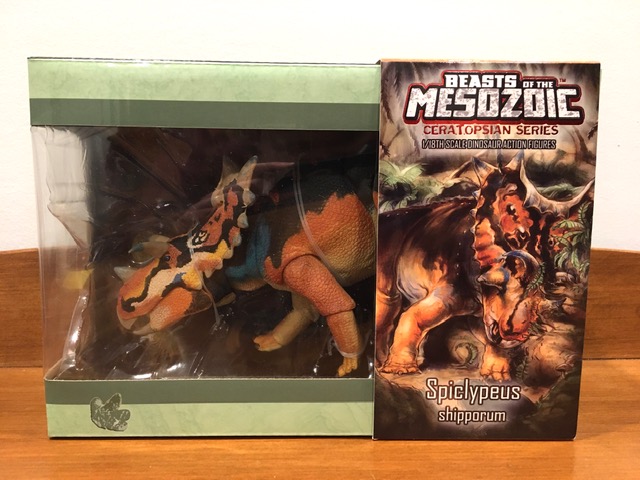
This is a particularly exciting review for me, as it’s the very first Spiclypeus toy in existence, but given that it’s a BotM product, it would be wrong not to talk about the packaging first. The artwork on the front depicts the great ceratopsian placidly scratching its head against a large fallen tree trunk. I’m quite fond of paleoart which shows dinosaurs at ease as opposed to engaging in mortal combat, so hats off to Shannon Beaumont for this fine work. The back of the box shows the entire second wave as well as a brief description of Spiclypeus. It was an average-sized ceratopsian hailing from the Judith River Formation of Montana, making it a contemporary of Albertaceratops, Avaceratops, Judiceratops, Medusaceratops, and Mercuriceratops. Other known herbivores from this region are the hadrosaurs Brachylophosaurus and Probrachylophosaurus and the ankylosaur Zuul (which I really want someone to make a toy of). Preying on all of these animals were the tyrannosaurs Daspletosaurus and Gorgosaurus, both of which will be included in the upcoming BotM Tyrannosaur Series. Better keep saving your money!

The packaging insert depicts a waterfall in a lush green temperate forest. Looks very tranquil and pleasant. There’s also a collectible card featuring the same Spiclypeus artwork and information as on the box. In addition, there’s a small instruction sheet advising you to either immerse the tail piece in hot water or heat it with a hairdryer for 20 seconds before attaching it to the ball joint on the figure’s rear. You are also advised to apply low heat to any stiff joints rather than force them, which is sound advice.
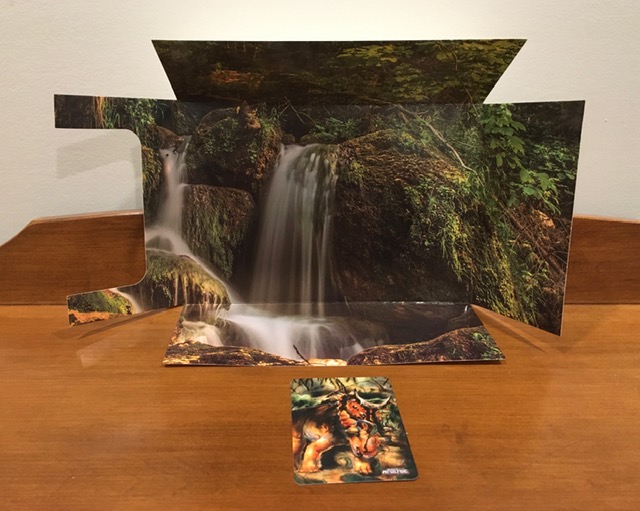
And now let’s look at the Spiclypeus itself, in a special location no less. Welcome to the Canadian Museum of Nature in Ottawa, Ontario! This display case contains the remains of the holotype specimen of Spiclypeus, along with a cast of the skull. I did get a couple of odd glances from visitors while photographing the figure, but fortunately, I’m at the wonderful age where I really don’t care what anyone else thinks of me. 🙂 I didn’t do any comparison shots at the museum, however, as I didn’t want to bring that many toys with me or take up too much time hogging the display.
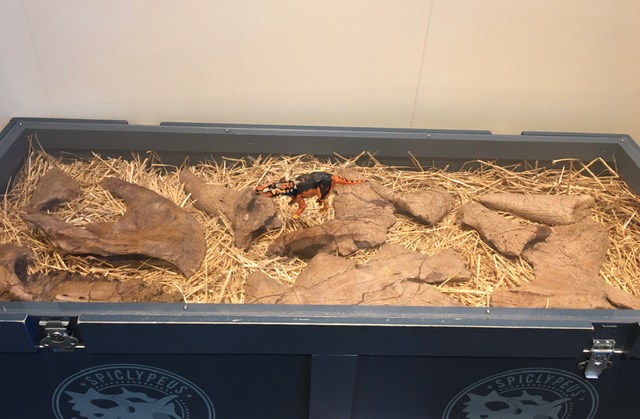
All the colour schemes for the BotM ceratopsians are taken from real reptiles and in this case, a baby leopard gecko was the partial inspiration. The main colour on this figure is a slightly burnt orange with cream for the underbelly and the insides of the limbs and medium brown for the claws. The back is painted blue-black with a few red-brown and bright blue spots. The neck features large blue patches and there are blue-black stripes running down the tail. The head is decked out in orange, cream, and blue-black with dark pink for the inside of the mouth, cream for the tiny teeth, and beige for the rostral and the predentary (which form the beak), the nasal and postorbital horns, and the epiparietals. The eyes are glossy blue, the quadrates feature small blue patches, and the horns are tipped with blue as well.

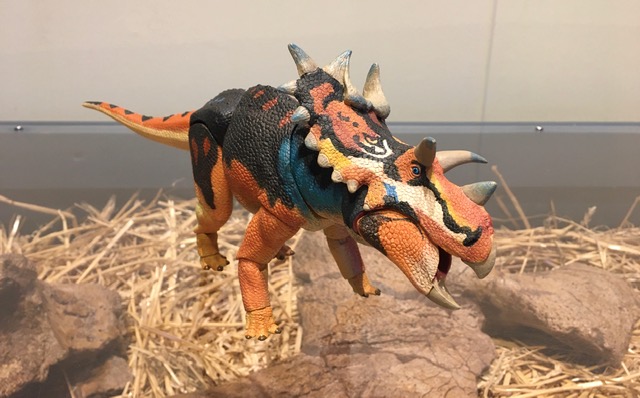
The black markings on the frill bear an unsettling resemblance to a pair of enormous leering eyes, which probably would have come in handy for display or intimidation purposes. Overall, this is a very bold and striking colour scheme, one which I rather like.

Small scales of varying shape cover the Spiclypeus’ entire body save, of course, for its beak and horns, which have faint grooves. There are also a few rows of tiny osteoderms running down the back and tail. While it is not the most elaborate skin texture I’ve seen on a ceratopsian figure, it is all very well-sculpted and in keeping with what we know from fossilized skin impressions of ceratopsians. Perhaps more important is the fact that the Spiclypeus’ body has the right shape and proportions overall, including hips that are narrower than the rib cage, a relatively short tail, and muscular limbs. The feet have the correct number of claws (three on the front ones and four on the hind ones) and the digits are properly sized and aligned.
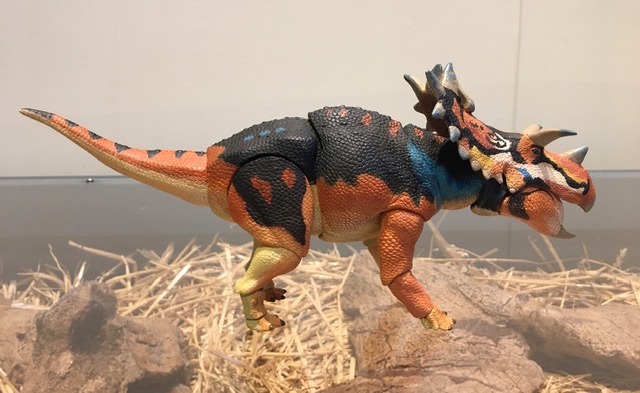

The Spiclypeus is one of the smaller beasts in the series, but as a 1/18 scale product, it’s still bigger than most of the ceratopsian figures from other companies. When its limbs are in a neutral stance and its tail is outstretched, it has a height of just under 12 cm tall at the tips of its epiparietals and a length of slightly over 27 cm. Indeed, this makes it one of the largest ceratopsians currently in my collection.

The top five dinosaur makers, hands down.
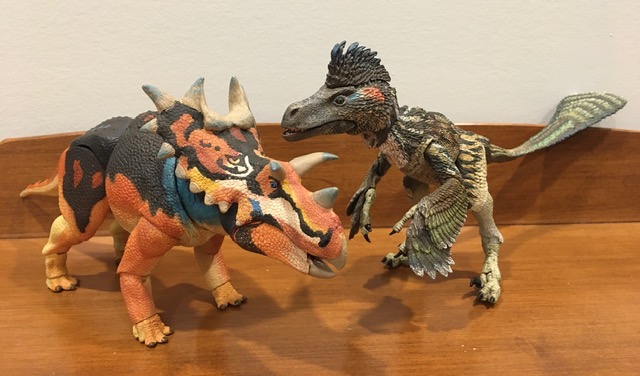
The easiest means to tell the many known ceratopsian species apart from one another is, of course, their distinctive headgear. Spiclypeus, whose name appropriately means “spiked shield,” possessed a triangular nasal horn, a pair of relatively short postorbital horns with tips facing out to the sides as opposed to forward, and an impressive arrangement of epiparietals sprouting from the upper rim of its long frill. The middle four epiparietals curled forward over the frill in a manner similar to the ones found on Kosmoceratops, while the first two epiparietals flanking the curl on either side were rather long and blade-like. As you can plainly see, these unique physcial features have been wonderfully rendered on this figure.

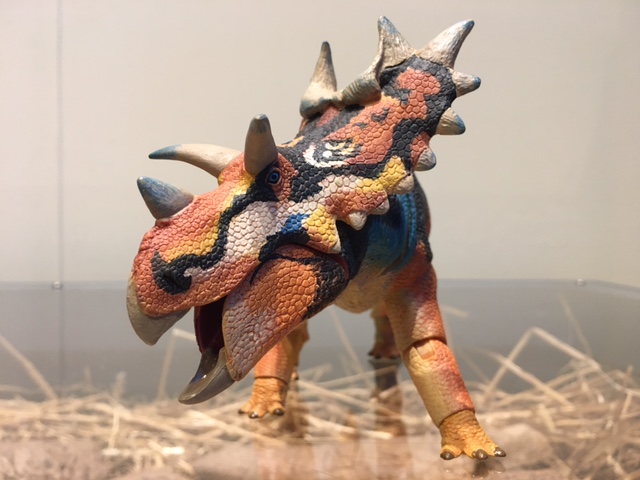
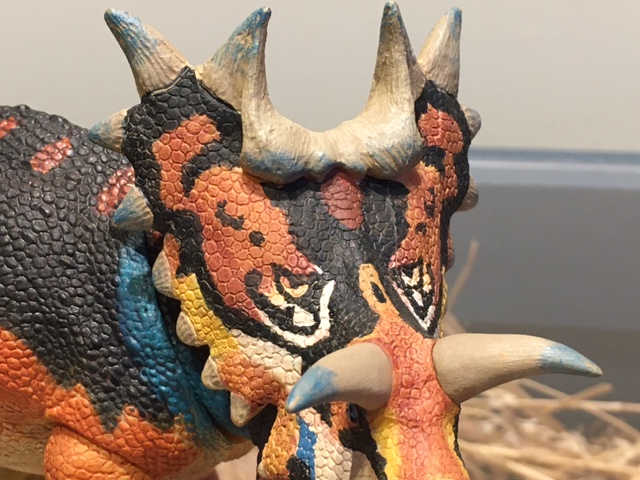
And now let’s talk about this figure’s articulation. Actually, let’s first talk about the need to gently loosen up the articulation, as the joints on the BotM ceratopsians tend to be pretty stiff at first. Too much applied pressure can easily result in breakage if you’re not careful with them. Immersing the figure in hot water or holding it front of a hairdryer really is probably your safest bet, although I will admit that I did neither. I simply sat and manipulated each joint very cautiously until it became loose enough.
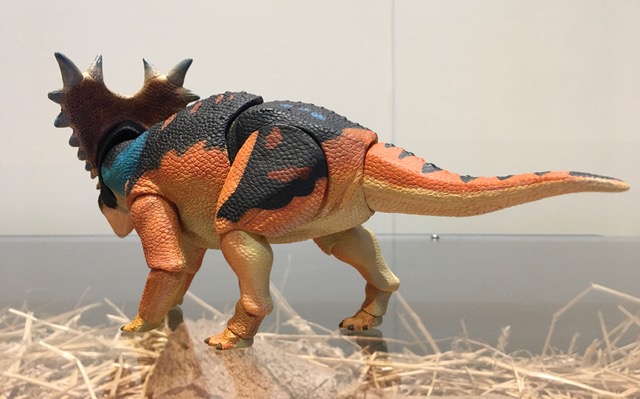

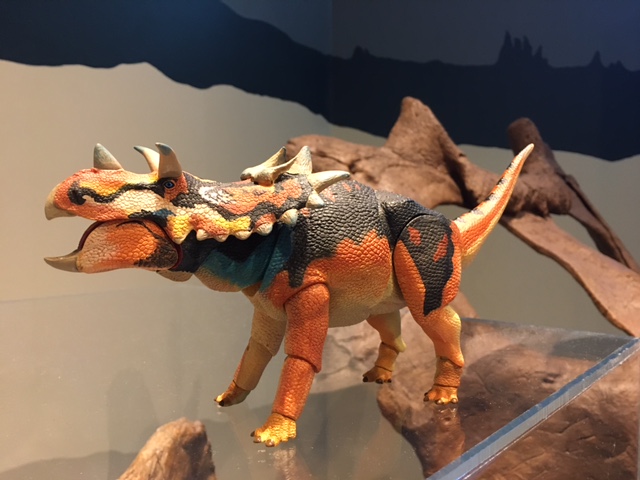
Like all the BotM ceratopsids, the Spiclypeus has ball joints at the base of the skull, the neck, the shoulders, the midsection, the hips, the base of the tail, and the wrists and hind feet. The elbows, knees, and ankles, meanwhile, feature hinge-and-swivel joints. Finally, the lower jaw is hinged as well, although since the upper jaw doesn’t move, the Spiclypeus ends up with an underbite when its mouth is wide open. Also, turning the midsection joint too much in either direction causes the ball joint on my figure to pop out. Fortunately, it’s easy to pop it right back in again.
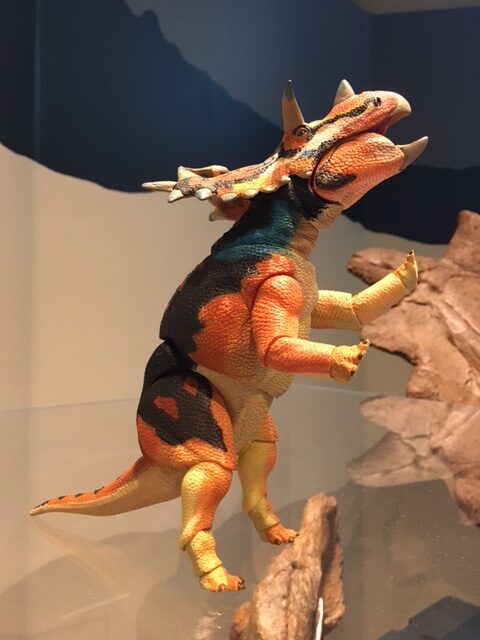

As you can see from the images, such articulation allows for a wide variety of dynamic poses, or more relaxed ones if that’s what you prefer. And naturally, being quadrupedal means that the Spiclypeus and the rest of the ceratopsians are much more stable than the raptors. This beastie can take a walk, gallop away, rear up on its hind legs, put on an impressive display, or sit down for a little rest. It can’t, however, lower or raise its head very much, so no grazing or taking a drink or charging like a bull or a bighorn sheep. It also can’t really achieve a good lying down pose, but it can be made to look like it’s struggling frantically as a tyrannosaur triumphantly places a foot atop it!
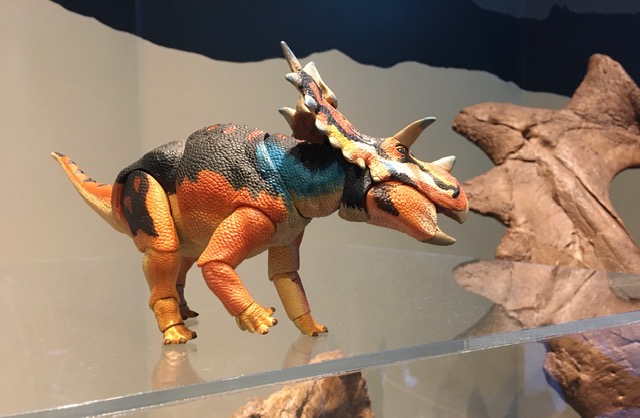
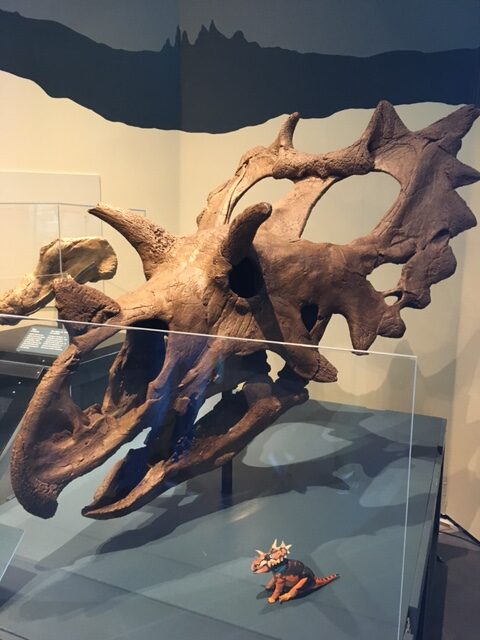
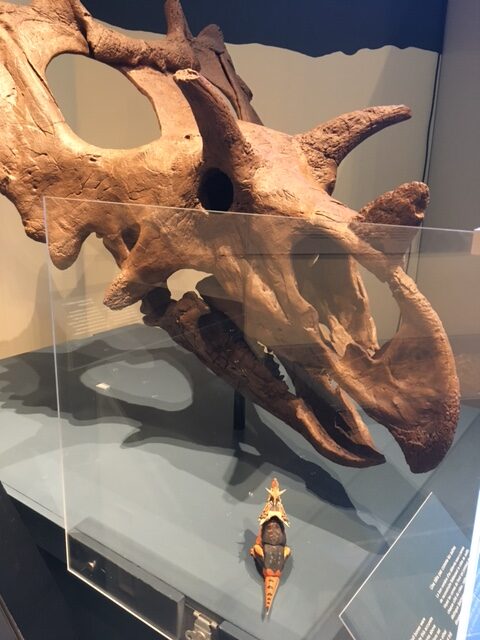

As I mentioned at the start, this is the very first figure of Spiclypeus, and it is indeed a superb one! Cool colour scheme, excellent sculpting, scientifically accurate, and definitely a lot of fun to fiddle with! That said, as a Creative Beast product, you need to be aware that it is not intended for rough play and is definitely not a toy for children. Always take care when posing it and don’t push your luck by displaying it in a dynamic pose on a shelf where it stands a chance of falling off. You also need to be aware that these BotM figures are anything but cheap. The Spiclypeus retails for $49.99 US on Creative Beast’s website as well as Dan’s Dinosaurs, and again, it’s one of the smaller ceratopsians in the series. But as long as you’re fine with all that, then I highly recommend this fantastic beast of the Mesozoic era!

Disclaimer: links to Ebay and Amazon on the DinoToyBlog are affiliate links, so we make a small commission if you use them. Thanks for supporting us!




I’m happy to report that I’ve replaced most of the images with new ones taken at the CMN! It was always my original intention to do a photo shoot on location, but then along came the pandemic. Even after the museum finally reopened, the Spiclypeus display was removed for quite some time in order to allow patrons to distance themselves better. And even after the display was reinstalled, it took me a while to find time in my schedule for a solo visit!
Hope you all like the new images!
Nice review of this figure. It is the one I was really eyeing to get as a representation for my collection.
Thanks! Although I hope you get another ceratopsian as well, because I’d enjoy reading your review of it.
One of my favorites from the ceratopsian series.
A great review of a figure i’m looking forward to. The type specimen of Spiclypeus had damage to the frill, believed to be caused by the brow horn of a rival. Although, given that the brow horns on Spiclypeus are so short, I have to wonder about this assessment.
The left front leg also had very significant injury to the humerus, causing the leg to rotate almost 90 degrees in life. These two injuries might be something I add to my figure when it comes.
I think this one might be the next one I purchase. Good thing I’m starting a new job next month!
How cool is that spiclypeus. Magnificent review and thanks for advising that this figure must be careful with it when it comes to handling or preventing it from falling off a shelf. BoTM ceratopsids are very nice but from what I see very fragile, they are obviously intended for us collectors as you point out and not for a child. Its coloring is more realistic than other figures in the BoTM series such as the styracosaurus or kosmoceratops to give just two examples.
Thanks!